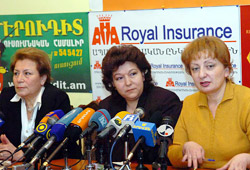Spring in Armenia is strange. It is not usual, but rather electoral once every four-five years. Armenia has been electing a parliament and president in the spring for approximately ten years now. I don’t know about spring, but the pre-electoral spring came too soon this year. We saw garbage on the streets instead of grass and flowers after the melting of the snow. The frontals of the buildings were covered with political party posters. There are names and pictures of political parties posted everywhere, just like during the previous electoral campaigns. There is nothing new, except one thing. The grants from the West have left a trace in at least one field. The public which lost its interest in the elections a long time ago is now interested in women’s participation in the elections. It is quite possible that this is the result of the “Women’s Month” running form Rosa Luxemburg’s March 8th until the day of good tidings April 7. Those dates became state holidays.
During these days of the pre-electoral period, 131 deputy certificates are up for election or for auction. Based on the data of the Central Electoral Committee, 1497 candidates have registered for 131 alluring pieces of public goods. The Armenian opposition has been trying to convince the public for years that the elections are an absurd process and that the authorities come up with the results on their own. They convince, but they also generously participate in the elections each time.
Many Western non-governmental organizations keep trying to implement programs in Armenia with the purpose of making Armenian women become more active in Armenian social life. The upcoming National Assembly elections are the period of evaluation of the effectiveness of their work. Nearly 23% of the National Assembly nominees are female: 344 women are included in the proportional electoral system, forming part of the lists of the parties and/or alliances. There are lists that even provide the top three spots for women. That can be considered a tribute to the West because there is not much involvement of women in Armenian social/political life. The “trusted” high position of women in the National Assembly has always been the position of head of the standing committee (obviously the committee on social issues). Women have always led “secondary” ministries of the Armenian government, including the ministries of Environmental Protection, Social Issues and Culture. For example, when the mining industry picked up speed in Armenia, in other words, when the Environmental Protection Ministry became primary, it immediately turned into a ministry governed by men.
According to modern Western terms, it is peculiar to see 23% of women’s involvement in parliament when you have gender issues. The women’s list includes well-known and unknown activists, businesswomen, teachers, government employees and unemployed. But there is no need to worry. After all, men formed the lists; thus, they kept the fleeting spots for themselves. That 23% will not stay in parliament. Armenian male deputies will be able to trick the Western experts and female Armenian voters. The proportional electoral lists are most probably formed based on this logic.
The picture is totally different in the majority electoral system. There is theoretically no chance to trick anyone in this case. There are only seven precincts with female candidates (one candidate in each of the 5th, 8th, 19th and 23rd precincts and two candidates in each of the 11th, 12th and 31st precincts). Eight of the eleven women up to battle in the elections are members of political parties. The majority of the female candidates are from the “Country of Law” party (four in number). Three of the non-partisan female candidates are unemployed and have been nominated by a political initiative. These numbers verify the public stereotype that women are more pragmatic than men. Thus, they will not compete in an unequal struggle and will save their time and energy.
With complete distrust in the results of the previous and upcoming elections, I claim that at least a quarter of the 173 nominated deputies will collect three-digit votes. So, they are not really competitive for the candidates with real opportunities in the electoral struggle. According to experts, the candidate must have up to half a million dollars during the pre-electoral period in order to have any real chances of getting elected in the majority electoral system. That is the least amount of money required to have during the electoral campaign. That is why women make up 6% in this list. According to experts, none of them, not even the partisans, don’t own any real funds. So, there is practically no chance for the female deputy candidate to get elected in the majority electoral system. Despite that, it is nice to see women involved in politics, even if it is just a slogan. Who knows? Perhaps participation is really more important than winning.
I wish all women a Happy March 8th and console us Armenians and especially Armenian women by saying that it won’t go on like this. Armenian society will progress and appreciate women so much that half of the Armenian parliament will consist of female deputies.
P.S. If I were not to make a phony statement on this occasion, I would write the last sentence the following way: “Armenian society will progress and will underestimate women so much that half of the Armenian parliament will consist of female deputies.

